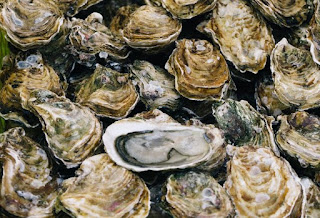Cuisine Jomon Style
 |
| Image of oysters. (Photo from Forbes Magazine) |
Do you ever wonder what to make for dinner (or lunch, for that matter)? Why not look to the ancient Japanese Jomon culture for inspiration. The Jomon is a period in Japanese history that emerged at the end of the Late Pleistocene and into the Early Holocene. It was a period marked by the end of the Ice Age when global climates warmed and sea levels rose. With these changes in temperature and rainfall came new food resources to gather and hunt, such as acorns and chestnuts from the deciduous broadleaf forests as well as an abundance of seafood.
The Jomon diet varied depending on the seasons, regional tastes, and the available resources which spanned 3,500 kilometers of the Japanese archipelago. For example, in the coastal regions, one might collect seaweed, oysters, and shellfish or hunt marine mammals. Near river estuaries and tidal flats, one could gather mud snails and clams from the brackish waters. Inland, one could hunt boar and deer and collect mushrooms and wild grapes.
Archaeological remains of both the animals and plants that were hunted and collected by people of the Jomon period can be seen not only in the carbonized residue from hearths but also from geochemical analysis of biological residues adhering to pottery. This type of analysis enables archaeologists to see the signatures of lipids, enzymes, and compounds that are specific to certain types of food. At this moment, it is not possible to identify the exact species being used by the Jomon but we can get a good sense of which groups of animals and plants made up a large portion of their diets.
There is extensive evidence, both in coastal sites and inland, for very intensive plant harvesting, especially nut-bearing trees. The ways in which these trees had been modified and the sheer number of nuts found at archaeological sites suggest that Jomon hunter-gatherers may have been cultivating and managing these forests to increase the production of nuts. The sites also contain large grinding slabs with hand stones that would have been used to process the nuts to prepare them for flours and pastes.
 |
| Grinding stones (courtesy of Jamon-Japan) |
So if you would like to experiment with Jomon recipes, why not try a soup of acorn flour dumplings boiled with root vegetables and spiced with fresh herbs and rock salt, or perhaps try making cookies with a dough of crushed chestnuts and mixed with the meat of wild boar and then brushed with egoma oil? You can enjoy your meal with a brewed wine made from elderberries, mulberries, or wild grapes.
If you would like to try your hand at processing your own acorns, here is your eight-step guide. (Adapted from the Old Farmer's Almanac)
1. When you are collecting acorns, look for brown acorns with the cap still on them.
2. Rinse the acorns in cold water and then place them in a bowl to soak and remove any acorns that have floated to the top.
3. Rinse and dry the acorns.
4. Then remove the caps and use a rock to remove the shell.
5. Don't eat them yet because the bitter tannins need to be removed!
6. Boil the shelled nuts until the water is the color of tea.
7. Keep repeating the process with fresh pots of water until the boiled water is clear
Importantly, don't let the acorns cool in this process.
8. Then immediately dry the acorns in the sun
If you would like to try your hand at processing your own acorns, here is your eight-step guide. (Adapted from the Old Farmer's Almanac)
1. When you are collecting acorns, look for brown acorns with the cap still on them.
2. Rinse the acorns in cold water and then place them in a bowl to soak and remove any acorns that have floated to the top.
3. Rinse and dry the acorns.
4. Then remove the caps and use a rock to remove the shell.
5. Don't eat them yet because the bitter tannins need to be removed!
6. Boil the shelled nuts until the water is the color of tea.
7. Keep repeating the process with fresh pots of water until the boiled water is clear
Importantly, don't let the acorns cool in this process.
8. Then immediately dry the acorns in the sun
Comments
Post a Comment